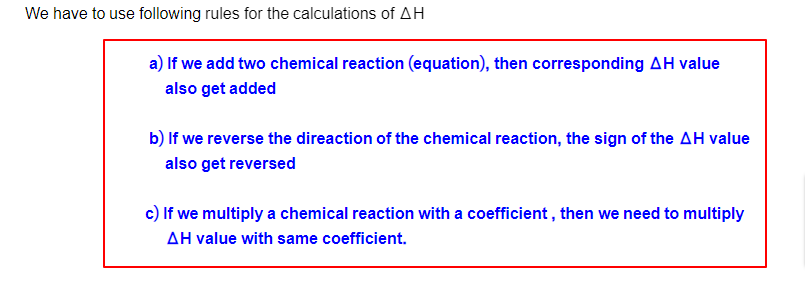Given the standard enthalpy changes for the following two reactions: (1) 4C(s) + 5H₂(g)-C4H10(g) AH = -125.6 kJ (2) C₂H4(g) 2C(s) + 2H₂(g) AH = -52.3 kJ what is the standard enthalpy change for the reaction: (3) 2C₂H4(g) + H₂(g) C4H10(g) AH° = ? Submit Answer kj Retry Entire Group R 8 more group attempts remaining values
Thermochemistry
Thermochemistry can be considered as a branch of thermodynamics that deals with the connections between warmth, work, and various types of energy, formed because of different synthetic and actual cycles. Thermochemistry describes the energy changes that occur as a result of reactions or chemical changes in a substance.
Exergonic Reaction
The term exergonic is derived from the Greek word in which ‘ergon’ means work and exergonic means ‘work outside’. Exergonic reactions releases work energy. Exergonic reactions are different from exothermic reactions, the one that releases only heat energy during the course of the reaction. So, exothermic reaction is one type of exergonic reaction. Exergonic reaction releases work energy in different forms like heat, light or sound. For example, a glow stick releases light making that an exergonic reaction and not an exothermic reaction since no heat is released. Even endothermic reactions at very high temperature are exergonic.
![J
Given the standard enthalpy changes for the following two reactions:
(1) 4C(s) + 5H₂(g)-C4H10(g)
AH = -125.6 kJ
(2) C₂H4(g)-2C(s) + 2H₂(g)
AH° = -52.3 kJ
what is the standard enthalpy change for the reaction:
(3) 2C₂H4(g) + H₂(g) C4H10(g) AH° = ?
4
Submit Answer
R
F4
F
%
5
F5
T
kj
#tv
Retry Entire Group 8 more group attempts remaining
G
^
[Review Topics]
[References]
Use the References to access important values if needed for this question.
6
MacBook Air
F6
H
&
1
7
F7
U
8
▷II
FB
1
(
9
K
F9
O
)
O
F10
L
Previous
11 +
=
Next
Save an
1
FI
L](/v2/_next/image?url=https%3A%2F%2Fcontent.bartleby.com%2Fqna-images%2Fquestion%2F18395f57-75e3-4bdb-980a-ed8850989594%2F09752011-c1f0-451a-99ec-1b986ed7c7d0%2F1acp9jc_processed.jpeg&w=3840&q=75)
![Given the standard enthalpy changes for the following two reactions:
ΔΗ° =
4
what is the standard enthalpy change for the reaction:
R
Submit Answer
(1) 2Zn(s) + O₂(g) → 2ZnO(s)
(2) Zn(s) + Cl₂ (g) → ZnCl₂ (s)
F4
F
(3) 2ZnCl₂ (s) + O2(g) → 2ZnO(s) + 2Cl2 (g)
AH° = ?
%
5
kj
F5
[Review Topics]
[References]
Use the References to access important values if needed for this question.
Retry Entire Group 8 more group attempts remaining
T
tv
G
^
6
MacBook Air
F6
H
&
7
AH = -696.6 kJ
AH = -415.0 kJ
2
F7
U
* 00
8
J
DII
F8
(
9
F9
K
0
DO
J
F10
,!
Previous
+
Next
Save an
11](/v2/_next/image?url=https%3A%2F%2Fcontent.bartleby.com%2Fqna-images%2Fquestion%2F18395f57-75e3-4bdb-980a-ed8850989594%2F09752011-c1f0-451a-99ec-1b986ed7c7d0%2Fngm8s6g_processed.jpeg&w=3840&q=75)

Step by step
Solved in 4 steps with 4 images









